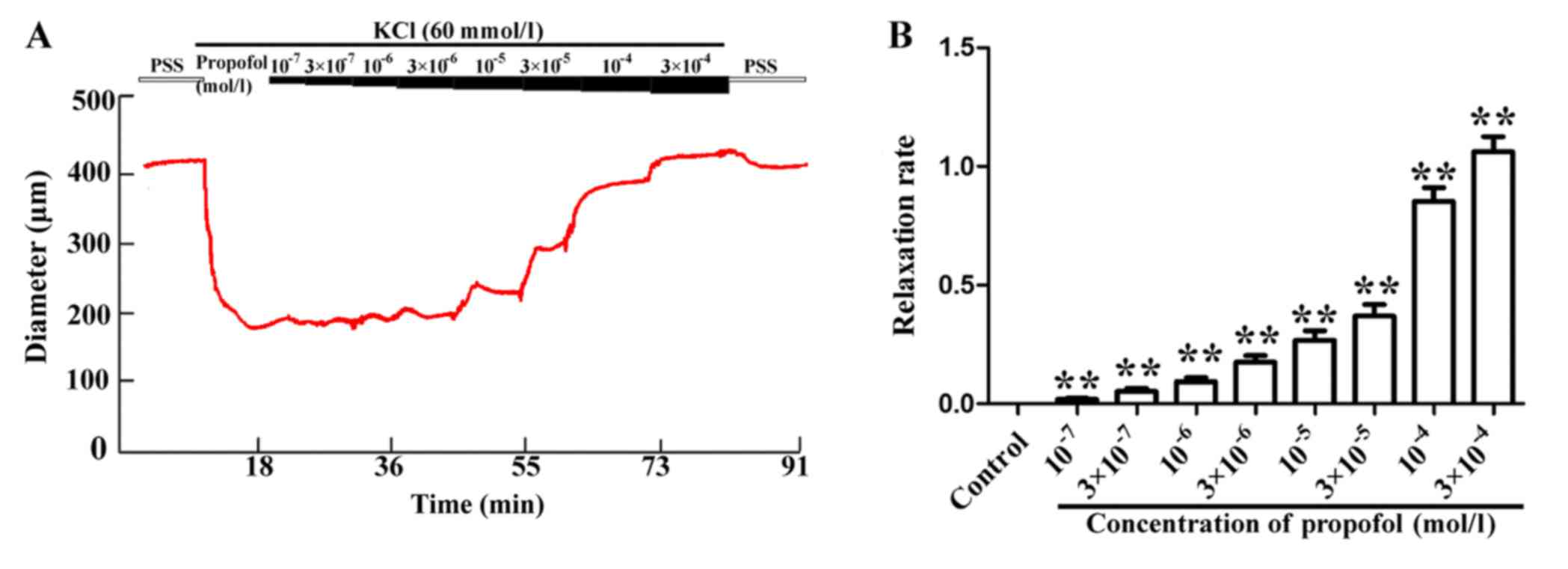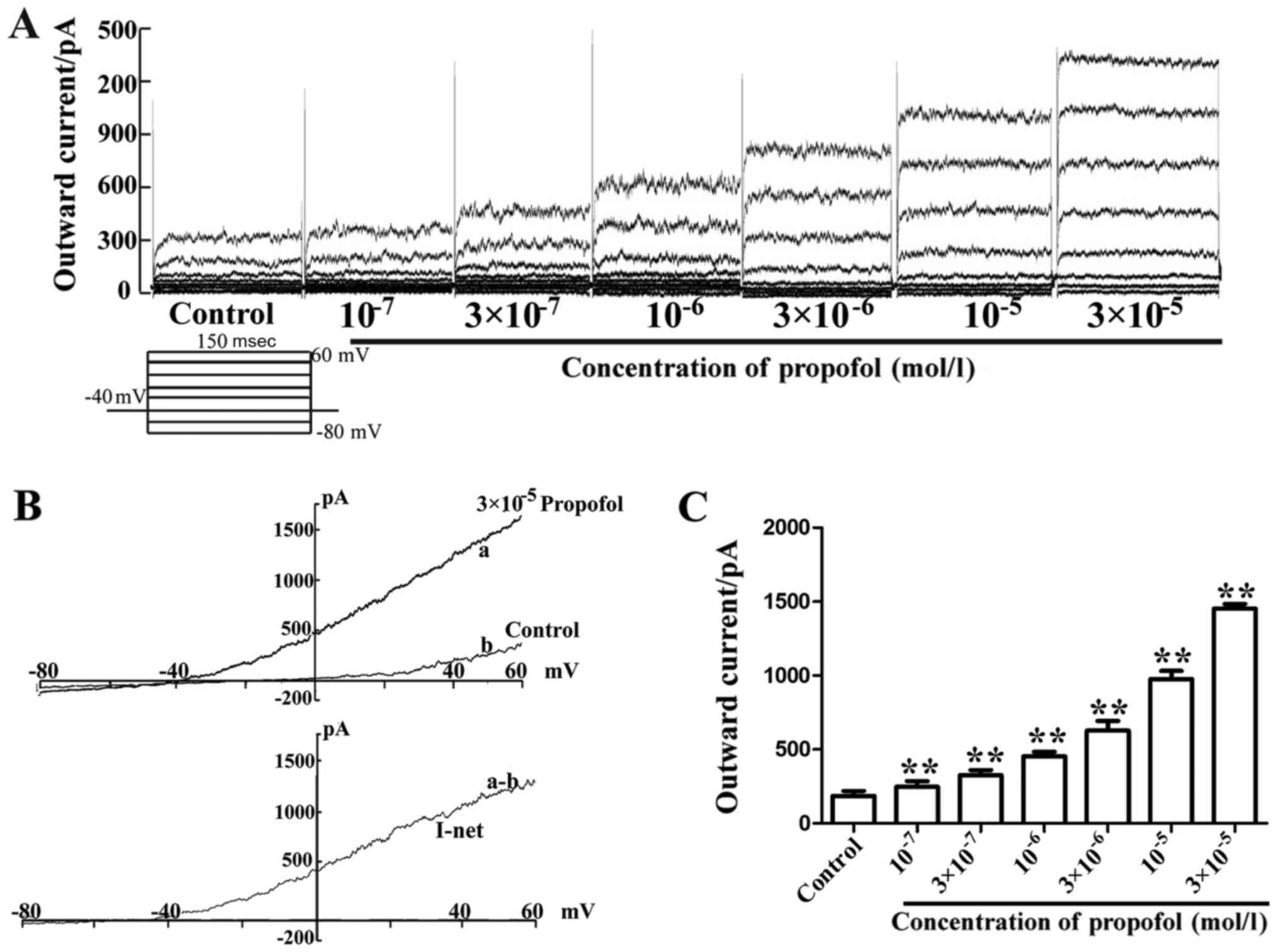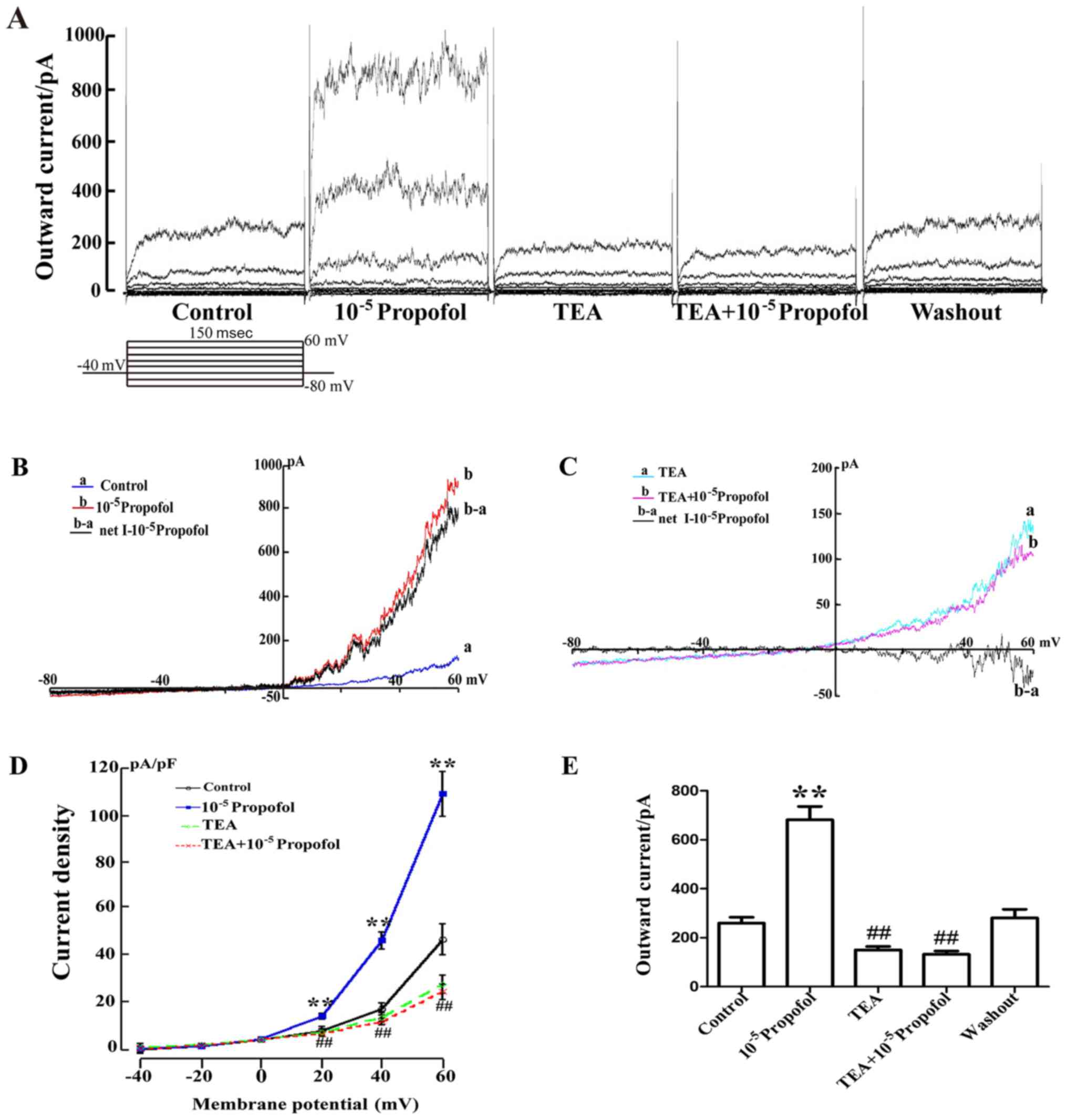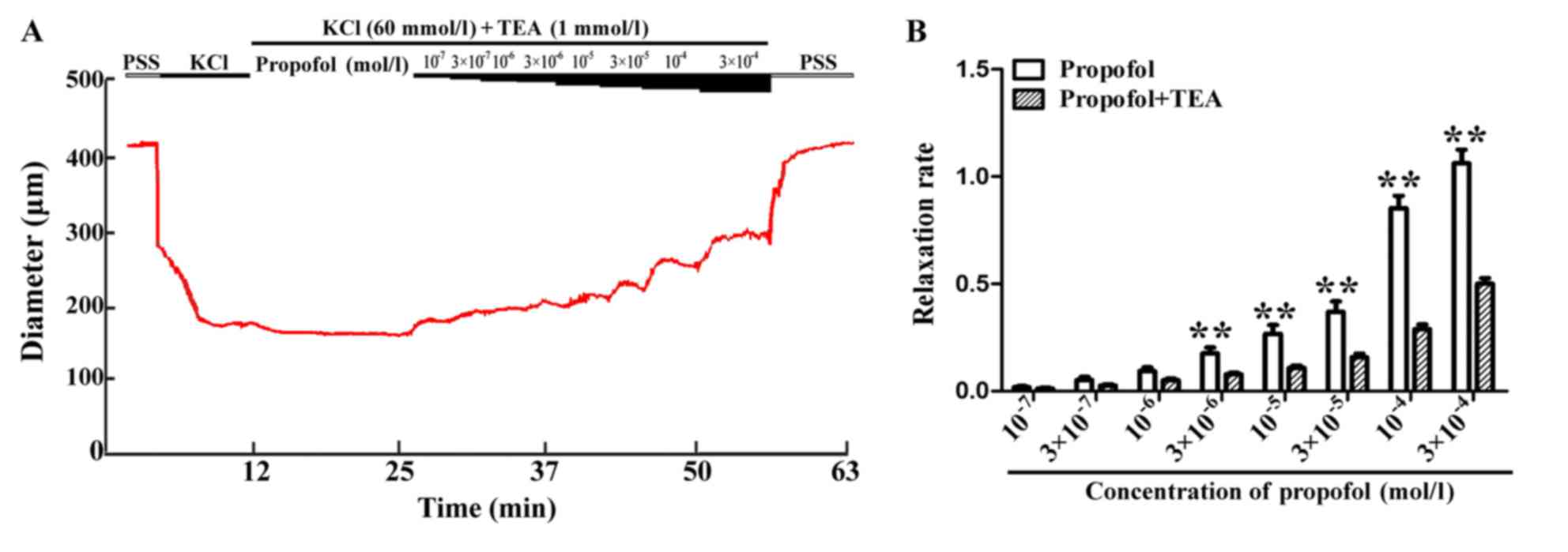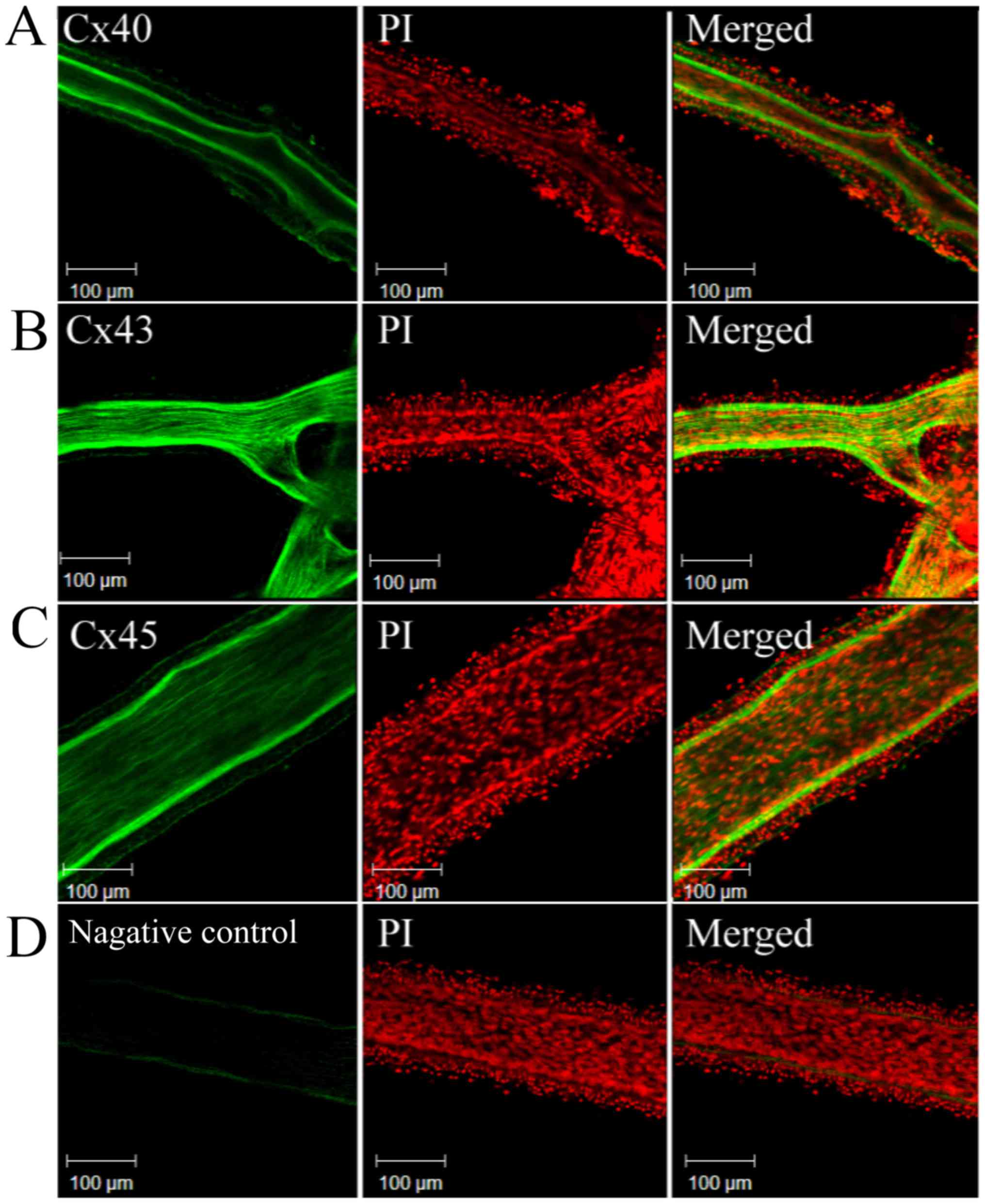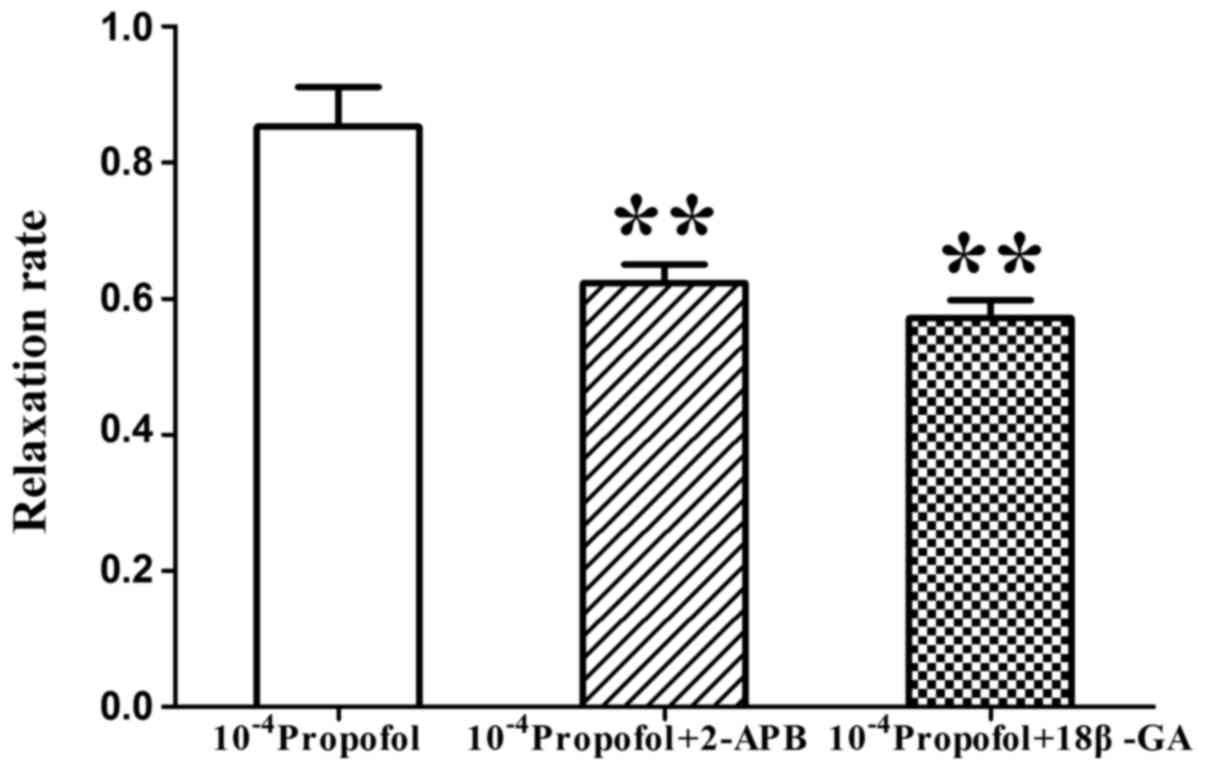|
1
|
Gragasin FS and Davidge ST: The effects of
propofol on vascular function in mesenteric arteries of the aging
rat. Am J Physiol Heart Circ Physiol. 297:H466–H474. 2009.
View Article : Google Scholar : PubMed/NCBI
|
|
2
|
Liu XR, Tan XQ, Yang Y, Zeng XR and Tang
XL: Propofol increases the Ca2+ sensitivity of BKCa in the cerebral
arterial smooth muscle cells of mice. Acta Pharmacol Sin. 33:19–26.
2012. View Article : Google Scholar : PubMed/NCBI
|
|
3
|
Au AK and Matthew Fields J: Ultrasound
measurement of inferior vena cava collapse predicts propofol
induced hypotension. Am J Emerg Med. 35:508–509. 2017. View Article : Google Scholar : PubMed/NCBI
|
|
4
|
Sakai Y, Kawahito S, Takaishi K, Mita N,
Kinoshita H, Hatakeyama N, Azma T, Nakaya Y and Kitahata H:
Propofol-induced relaxation of rat aorta is altered by aging. J Med
Invest. 61:278–284. 2014. View Article : Google Scholar : PubMed/NCBI
|
|
5
|
Lam CF, Chang PJ, Chen YA, Yeh CY and Tsai
YC: Inhibition of ATP-sensitive potassium channels attenuates
propofol-induced vasorelaxation. Crit Care Resusc. 12:186–190.
2010.PubMed/NCBI
|
|
6
|
Zhang G, Cui J, Chen Y and Ma J: The
relaxant effect of propofol on isolated rat intrapulmonary
arteries. Korean J Physiol Pharmacol. 18:377–381. 2014. View Article : Google Scholar : PubMed/NCBI
|
|
7
|
Folino T and Parks L: Propofol.
StatPearls. StatPearls Publishing StatPearls Publishing LLC,
Treasure Island (FL). 2017.
|
|
8
|
Wang Y, Zhou H, Wu B, Zhou Q, Cui D and
Wang L: Protein Kinase C isoforms distinctly regulate
Propofol-induced Endothelium-dependent and Endothelium-independent
vasodilation. J Cardiovasc Pharmacol. 66:276–284. 2015. View Article : Google Scholar : PubMed/NCBI
|
|
9
|
Hill MA, Yang Y, Ella SR, Davis MJ and
Braun AP: Large conductance, Ca2+-activated K+ channels (BKCa) and
arteriolar myogenic signaling. FEBS Lett. 584:2033–2042. 2010.
View Article : Google Scholar : PubMed/NCBI
|
|
10
|
Yang Y, Li PY, Cheng J, Mao L, Wen J, Tan
XQ, Liu ZF and Zeng XR: Function of BKCa channels is reduced in
human vascular smooth muscle cells from Han Chinese patients with
hypertension. Hypertension. 61:519–525. 2013. View Article : Google Scholar : PubMed/NCBI
|
|
11
|
Brayden JE and Nelson MT: Regulation of
arterial tone by activation of calcium-dependent potassium
channels. Science. 256:532–535. 1992. View Article : Google Scholar : PubMed/NCBI
|
|
12
|
Kohler R, Kaistha BP and Wulff H: Vascular
KCa-channels as therapeutic targets in hypertension and restenosis
disease. Expert Opin Ther Targets. 14:143–155. 2010. View Article : Google Scholar : PubMed/NCBI
|
|
13
|
Tykocki NR, Boerman EM and Jackson WF:
Smooth muscle ion channels and regulation of vascular tone in
resistance arteries and arterioles. Compr Physiol. 7:485–581. 2017.
View Article : Google Scholar : PubMed/NCBI
|
|
14
|
Tran CH, Vigmond EJ, Goldman D, Plane F
and Welsh DG: Electrical communication in branching arterial
networks. Am J Physiol Heart Circ Physiol. 303:H680–H692. 2012.
View Article : Google Scholar : PubMed/NCBI
|
|
15
|
Ampey BC, Morschauser TJ, Lampe PD and
Magness RR: Gap junction regulation of vascular tone: Implications
of modulatory intercellular communication during gestation. Adv Exp
Med Biol. 814:117–132. 2014. View Article : Google Scholar : PubMed/NCBI
|
|
16
|
Bou Saab J, Losa D, Chanson M and Ruez R:
Connexins in respiratory and gastrointestinal mucosal immunity.
FEBS Lett. 588:1288–1296. 2014. View Article : Google Scholar : PubMed/NCBI
|
|
17
|
Ma KT, Guan BC, Yang YQ, Nuttall AL and
Jiang ZG: 2-Aminoethoxydiphenyl borate blocks electrical coupling
and inhibits voltage-gated K+ channels in guinea pig arteriole
cells. Am J Physiol Heart Circ Physiol. 300:H335–H346. 2011.
View Article : Google Scholar : PubMed/NCBI
|
|
18
|
Figueroa XF, Lillo MA, Gaete PS, Riquelme
MA and Sáez JC: Diffusion of nitric oxide across cell membranes of
the vascular wall requires specific connexin-based channels.
Neuropharmacology. 75:471–478. 2013. View Article : Google Scholar : PubMed/NCBI
|
|
19
|
Triggle CR, Samuel SM, Ravishankar S,
Marei I, Arunachalam G and Ding H: The endothelium: Influencing
vascular smooth muscle in many ways. Can J Physiol Pharmacol.
90:713–738. 2012. View Article : Google Scholar : PubMed/NCBI
|
|
20
|
Ilyas M, Butt MFU, Bilal M, Mahmood K,
Khaqan A and Ali Riaz R: A review of modern control strategies for
clinical evaluation of propofol anesthesia administration employing
hypnosis level regulation. Biomed Res Int. 2017:74323102017.
View Article : Google Scholar : PubMed/NCBI
|
|
21
|
Liu Q, Kong AL, Chen R, Qian C, Liu SW,
Sun BG, Wang LX, Song LS and Hong J: Propofol and arrhythmias: Two
sides of the coin. Acta Pharmacol Sin. 32:817–823. 2011. View Article : Google Scholar : PubMed/NCBI
|
|
22
|
Hall JE and Guyton AC: The
microcirculation and the lymphatic system: Capillary fluid
exchange, interstitial fluid, and lymph flowGuyton and Hall
Textbook of Medical Physiology. 13th. Elsevier; Philadelphia, PA:
pp. 182–185. 2015
|
|
23
|
Hall JE and Guyton AC: Vascular
distensibility and functions of the arterial and venous
systemsGuyton and Hall Textbook of Medical Physiology. 13th.
Elsevier; Philadelphia, PA: pp. 171–175. 2015
|
|
24
|
Yamamoto Y, Klemm MF, Edwards FR and
Suzuki H: Intercellular electrical communication among smooth
muscle and endothelial cells in guinea-pig mesenteric arterioles. J
Physiol. 535:181–195. 2001. View Article : Google Scholar : PubMed/NCBI
|
|
25
|
Brink PR, Ricotta J and Christ GJ:
Biophysical characteristics of gap junctions in vascular wall
cells: Implications for vascular biology and disease. Braz J Med
Biol Res. 33:415–422. 2000. View Article : Google Scholar : PubMed/NCBI
|
|
26
|
Haefliger JA, Nicod P and Meda P:
Contribution of connexins to the function of the vascular wall.
Cardiovasc Res. 62:345–356. 2004. View Article : Google Scholar : PubMed/NCBI
|
|
27
|
Klockgether-Radke AP, Schulze H, Neumann P
and Hellige G: Activation of the K+ channel BK(Ca) is involved in
the relaxing effect of propofol on coronary arteries. Eur J
Anaesthesiol. 21:226–230. 2004. View Article : Google Scholar : PubMed/NCBI
|
|
28
|
Sinha S, Sinharoy P, Bratz IN and Damron
DS: Propofol causes vasodilation in vivo via TRPA1 ion channels:
Role of nitric oxide and BKCa channels. PLoS One. 10:e01221892015.
View Article : Google Scholar : PubMed/NCBI
|
|
29
|
Ledoux J, Werner ME, Brayden JE and Nelson
MT: Calcium-activated potassium channels and the regulation of
vascular tone. Physiology (Bethesda). 21:69–78. 2006.PubMed/NCBI
|
|
30
|
Hu XQ and Zhang L: Function and regulation
of large conductance Ca(2+)-activated K+ channel in vascular smooth
muscle cells. Drug Discov Today. 17:974–987. 2012. View Article : Google Scholar : PubMed/NCBI
|
|
31
|
Allen T, Iftinca M, Cole WC and Plane F:
Smooth muscle membrane potential modulates endothelium-dependent
relaxation of rat basilar artery via myo-endothelial gap junctions.
J Physiol. 545:975–986. 2002. View Article : Google Scholar : PubMed/NCBI
|















